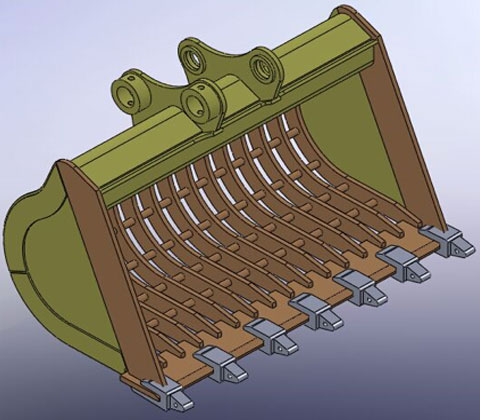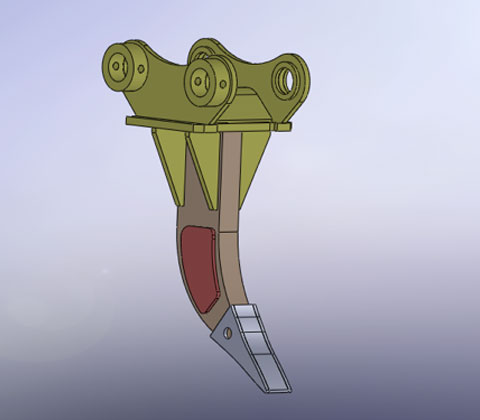Excavator Buckets and Attachments
RDW Excavator Parts carries substantial inventory of attachments to suit popular heavy machinery makes and models such as Caterpillar, Komatsu, Hitachi, JCB, Doosan, Daewoo, Kobelco, Yanmar, Sumitomo, Kubota, Volvo, and more. We have comprehensive stock ready for quick delivery (within 1-2 business days from order) to suit machines from 12 ton to 45 ton, but also cater to users up to 70 ton machines. Our range includes:
- GP (General Purpose) buckets
- Sieve (or skeleton) buckets
- Tilting buckets
- Rock buckets
- Trenching buckets
- Mud/batter buckets
- Rippers
- Compaction wheels
- Grabs and Grapples
- Used Attachments
Plus a comprehensive range of augers and not least probably the broadest range of Hydraulic attachments in Australia.
Our static attachments have been designed in Australia to meet the demanding conditions in our market, and are sourced from local and overseas manufacturing partners based on ensuring our quality standards are met, and the product can offer our customers the best value for money over the life cycle of their attachment.
Excavator Buckets
We don’t skimp of quality to provide a cut price product.
Product design and material selection are also paramount to how well your bucket will work. Rather than professing to know everything about buckets, we have listened to our customer feedback and our range continues to evolve and improve with minor tweaks from over 30 years of servicing the excavator market’s needs. Our customers tell us that their considerations include:
– easy to use and better efficiency – the bucket must be easy to fill to the optimum level. Half full buckets or buckets where the material spills back out of the bucket creates inefficiencies.
– good penetration – getting the power of the machine to give the appropriate force to give a nice clean cut in the hole or trench is important for efficiency and a good finish
– reducing wear on the bucket and GET. Through correct material selection in different parts of the bucket, the structure can be built to maximise bucket life. Key wear areas are built with different material and/or thicker wear materials. Items such as side cutters can be fitted to many models to reduce premature wear on the actual bucket structure.
– Good, reliable, easy to source GET – We also consider how our customers can benefit from using our products, so rather than have a unique design for instance in relation to teeth and edges, we have chosen to use readily available and affordable Cat J series teeth and Caterpillar compatible cutting edges. Whilst most of our customers come back to us for their Ground Engaging Tool replacement, it still means that when you are working in remote locations you can source GET from a local supplier to reduce any potential down time or freight costs.
There are many variables when using a bucket, such as operator experience and skill level, differences in machine attributes and performance, and ground conditions vary even on the same site. Whilst we could make claims about having the best or most efficient product, the truth is that there are so many variables that in total these differences amount to a few small percent at most. There are also competing priorities, for instance a heavier bucket is generally going to have a longer life, but at the same time it reduces the weight of the product the machine can lift to stay within its SWL (Safe Weight Limit), marginally increases fuel use etc.
What type of bucket do I need?
GP (or General Purpose) bucket is the base bucket that most machines have and does as the name suggests general digging duties. They are designed for low impact or lighter duties, such as soil, sand and clay. They are generally of a mid-range width dependent on the size of the machine, often 900mm on mid-sized machines.
Rock Buckets are for heavier duty applications with more compact ground conditions and/or more abrasive materials. Whilst broken up rocks is the first application to spring to mind, these buckets are also used in earths mixed with gravel, dense clay, sandy loam and similar conditions. The buckets are built with more material throughout to better withstand the tougher earth conditions.
Mud Buckets, also sometimes called batter bucket or trimming bucket, is made of lighter construction to reduce the weight of the bucket. It is generally a wide bucket, 1200mm or more, which makes it suitable for less dense material applications such as clearing ditches and loading top soil. As the name suggests, it’s also used in conditions with a high degree of water (like soft mud) where the wide width doesn’t compromise the cutting force and the light weight of the bucket helps keep the product within the SWL of the machine.
Tilting Buckets have the ability to hydraulically tilt the bucket to a different angle to the arm of the machine. This helps do work in restricted spaces such as batters or trenches, digging out dams, working on slopes etc. Because the bucket has cylinders and requires hydraulic connection, it is a more expensive type of product but can improve efficiency. As there are moving parts, it is important to get this product from a supplier that understands hydraulics and knows to make sure for instance that the design minimizes the amount of material around the cylinder and has a reliable cylinder design (good seals, correct tolerances etc).
Skeleton (or sieve) buckets are sometimes also referred to as sifting, sorting or a screening bucket. As the bucket has ribs with spaces between them, these buckets are used in demolition or rock or other sorting applications. The rib spacings are fixed, with spacings generally varying from 75mm upwards to suit the application.
Trenching Buckets are obviously used for digging trenches particularly for cable or pipe laying applications. It is important to get the correct width and digging depth to suit, so give particular consideration to that the width (with or without side cutter) gives you the correct trench in one pass.
Rippers are used to break up or fracture hard ground, shale or clay so the product can more easily be removed. This is not a “rock breaking” attachment. A good operator knows that the tooth penetrates the ground, but it is actually the shank of the ripper pulled along in a parallel movement to the surface that has the required break out force and design to break the ground the most efficiently. This gives the greatest life to both the ripper and the tip. A Multi-shank Ripper has an additional two teeth on the back sides of the ripper, allowing a wider rip area during the stroke of the machine. A Single Shank ripper is the more common design, and also more capable in harder ground conditions.
Compactor wheels are used to compact dirt or fill material back into a trench. Compactor wheels in its most common form has three strips of compaction pads with non-aligned compaction surfaces. Compaction wheels come in two forms:
Drum style compaction wheels is the more common version used in Australia. They consist of pads welded onto a drum and are lighter in weight. They are designed for compacting shallower layers (i.e. may require more passes on a deep trench), but don’t clog up as easily and therefore bearings etc aren’t as impacted by dirt and abrasion. The wider surface area of the drum compacts a wider surface faster, but as a result has less downward force.
“Cotton wheels” or disk style compaction wheels a built using separate disks or wheels running on a common shaft. This allows for more force on a smaller contact area, allowing harder compaction compared to the drum style wheel.
Compaction plates are a different type of compacting device to the above and require hydraulic lines to run to the plate. They have a flat surface and operate on the principal of “vibrating” the dirt to fill voids, hence giving very consistent finishing results, including a flat surface. The vibrating of the attachment combined with the force applied to the surface from the excavator compacts the surface wherever the boom will reach. Compaction plates can be used in a wide range of applications from trenching to large backfill operations and can also be used for vertical and inclined compaction applications.
Static or stiff arm Grabs are used for picking up items. They generally consist of two sets of “fingers” that interlock with each other through the movement of one of the sections but as there are many different types of designs, it is best to speak to one of our product experts to make sure you get the right design for your needs. These grabs are different to hydraulic grapples and are generally used in applications such as building demolition and construction debris, waste recycling and garbage/wood handling, land and brush clearing and some scrap yard applications.
For more information, please call us on 07-3715 0800 or email sales@rdw.com.au.





